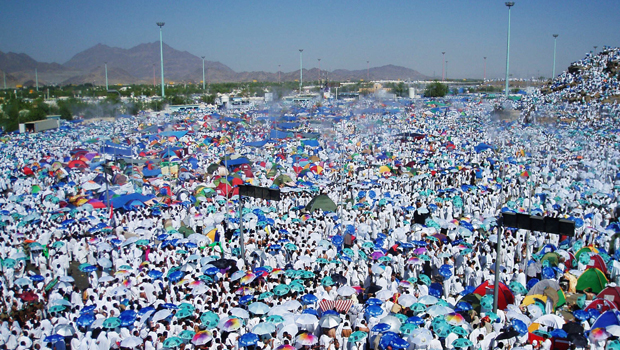The highlight of this year’s Haj is, without a doubt, the railway that is shuttling tens of thousands of Saudis, Indians, Pakistanis, Egyptians, Indonesians, Malaysians and Europeans. The high-tech trains picked up pilgrims with valid tickets at various stations at Mina and dropped them off at Arafat. The journey took less than 10 minutes and one could see the thrill on the faces of pilgrims. The authorities are equally delighted with the smooth flow of pilgrims. For us, the Mina-Arafat stretch used to be a nightmare in the past. Driving our motorbikes through the mass of pilgrims and extremely congested roads used to be the biggest challenge. Negotiating the many bends along the route was an exercise in jugglery. This time we simply got onto the train at Mina and arrived in Arafat without any hassle. The Saudis, Indians and Pakistanis that we met on the train were very happy at the service. “This is a great relief,” one of them gushed. “Full marks to the Saudi leadership.”
***
The most hallowed sight for pilgrims at Arafat is Jabal Al-Rahma, the Mount of Mercy. This is the place from which the Prophet Muhammad (peace be upon him) gave his farewell sermon. People wanted to get as close as possible to this point and by 9:10 a.m. the whole area was covered with pilgrims. From a distance the grey mountain gave the impression of being wrapped in a white sheet. However, it must be said that the assumption that Haj is colorless as most of the pilgrims are dressed in white is absolutely not correct. One can see the dash of colors in the pictures coming out of Arafat. The pilgrims use umbrellas of every color for shade. STC’s multi-colored, Mobily’s blue and Zain’s green umbrellas created a rainbow effect over the entire area.
***
Being at Arafat on this day of the Islamic calendar is considered the most important aspect of Haj. It was from this place 1,431 years ago that Prophet Muhammad delivered his unforgettable farewell sermon, enunciating far-reaching religious, economic, social and political reforms. Lady Evelyn Cobbold, an Englishwoman who became a Muslim and took the name of Zainab, described the standing scene at Arafat — wuqoof in Arabic — in moving words. “It would require a master pen to describe the scene, poignant in its intensity, of that great concourse of humanity of which I was one small unit, completely lost to their surroundings in a fervor of religious enthusiasm,” she wrote in her Haj journal decades ago. “Many of the pilgrims had tears streaming down their cheeks; others raised their faces to the sky that had witnessed this drama so often in the past centuries. The shining eyes, the passionate appeals, the pitiful hands outstretched in prayer moved me in a way that nothing had ever done before, and I felt caught up in a strong wave of spiritual exaltation. I was one with the rest of the pilgrims in a sublime act of complete surrender to the Supreme Will which is Islam.”
***
It was cool in the morning but as the sun rose on the plains of Arafat, so did the mercury. Despite the sun beating down on the pilgrims, they seemed unperturbed. On the horizon far ahead, we can see the magnificent minarets of Nimira, the only mosque in Arafat, rising up from the plains. It is only when one sees the pilgrims massed at some point such as Al-Nimira Mosque that there is an awareness of the millions involved in the event. Due to better management this year, the crowds moved smoothly. This is truly a blessing for all. How many are at this year’s Haj? The government has put the number of pilgrims from abroad at 1,828,195. The number from inside the Kingdom is more difficult to say.
***
First timers are quite awed by the arrangements and logistics. Everyone is mentioning the wonderful job done by Saudi authorities at this Haj. Even those of us who have been here before are finding this pilgrimage to be the most highly organized event ever witnessed. The area is clean. Transportation is very organized, again thanks to the high-tech railway. There are no queues for toilets or ablution facilities. Even frayed tempers are at a minimum this year. Most certainly this is partly due to the moderate weather. With all the logistics under control, the pilgrims are feeling increasingly confident that their journey of a lifetime will be a success.
***
Why does the pilgrimage take place during different months in a Gregorian calendar? That was an innocent query from a non-Muslim reader on our online edition. Well, here is an explanation. As the Islamic calendar is a lunar calendar, it shifts by about 11 days annually in the Gregorian calendar. This also results in Haj moving through all the seasons of the year over a 33-year period.
***
At Arafat, we saw that many pilgrims were resting under the neem trees. Major landscaping efforts were begun more than a decade ago at Arafat and the trees are watered year round by the authorities — although they are actually only needed on this one day each year. Planting trees is just a tiny part of what the Saudi government has done in the last decades to improve the pilgrimage and make the rituals accessible to Muslims from around the world. Billions of riyals are spent annually in infrastructure and service projects for Haj. The Saudi government and the country’s generous people take pride in serving the pilgrims. It is in their blood. Allah has therefore blessed their land.










